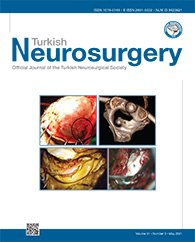2Izmir Kâtip Celebi University School of Medicine, Department of Neurosurgery, Izmir, Turkey DOI : 10.5137/1019-5149.JTN.31629-20.2 AIM: To evaluate the long-term efficacy of temporal lobe epilepsy (TLE) surgery, and to emphasize the factors affecting seizure outcomes such as surgical technique nuances and micro-neuroanatomical details in TLE cases.
MATERIAL and METHODS: In this retrospective analysis, 238 patients who underwent epilepsy surgery at Ankara University (Faculty of Medicine, Department of Neurosurgery) between 1990 and 2019 were included. All patients presented with symptoms of TLE. They were divided into two groups: those with neoplastic lesions and those with non-neoplastic brain lesions presenting with medically intractable epilepsy. In the non-neoplastic group, the patients underwent anterior temporal lobectomy with amygdalohippocampectomy (ATL+AH), whereas in the neoplastic group, the patients underwent tumor resection in addition to ATL+AH.
RESULTS: This study included 126 female (52.9%) and 112 male (47.1%) patients. The mean duration of epilepsy was 14.65 ± 9.29 years (0.08?46 years). The number of patients in the non-neoplastic and neoplastic groups was 190 and 48, respectively. The mean duration of follow-up was 15.82 ± 6.55 years (1?28 years). In the neoplastic and non-neoplastic groups, the Engel I seizure-free rates were 91.6% (44/48) and 90.5% (172/190), respectively. Furthermore, no mortality was observed among the groups.
CONCLUSION: Overall, effective seizure control was achieved with acceptable morbidity and complication rates in the neoplastic and non-neoplastic groups with surgical and micro-neuroanatomical nuances.
Keywords : Amygdalo-hippocampectomy, Anterior temporal lobectomy, Epilepsy surgery, Microneuroanatomy, Refractory temporal lobe epilepsy




